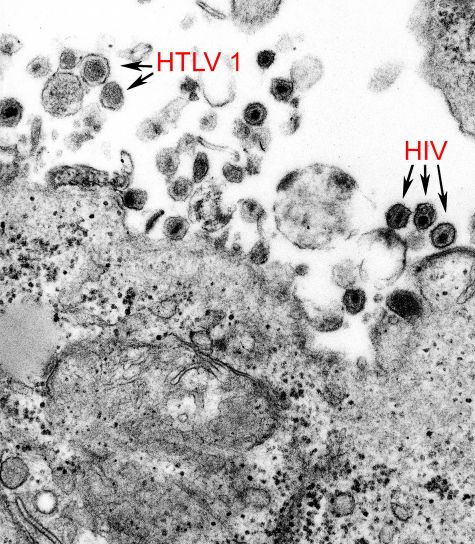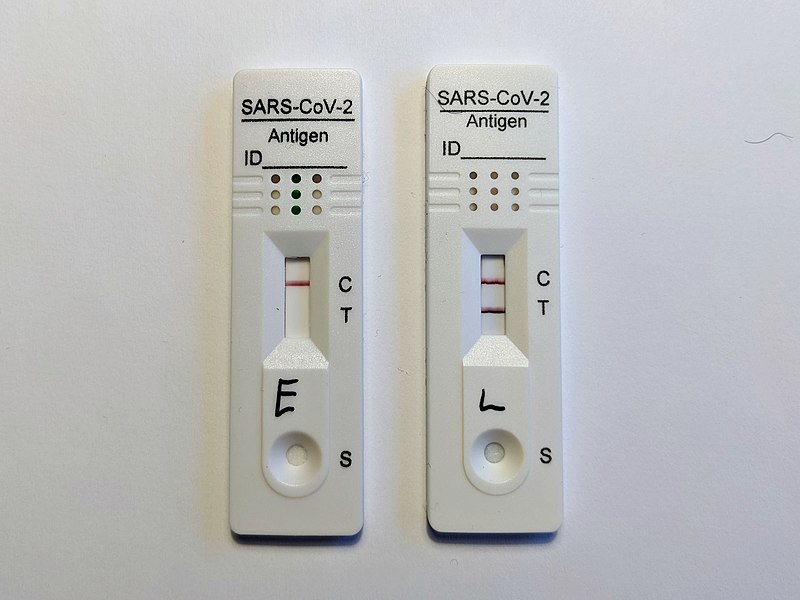The key difference between HTLV 1 and 2 is that HTLV-1 is a type of deltaretrovirus that causes adult T cell leukemia and a neurological disorder called HTLV-1 associated myelopathy, while HTLV-2 is a type of deltaretrovirus that is essentially non-pathogenic but rarely causes neurological diseases such as tropical or spastic ataxia.
The human T lymphotropic virus (HTLV) family of viruses is a group of retroviruses that can infect both humans as well as Old World monkeys. Four HTLVs that are capable of infecting humans have been identified so far. They are HTLV-1, HTLV-2, HTLV-3, and HTLV-4. HTLV-1 and HTLV-2 are delta retroviruses with similar genome structures and an overall nucleotide homology of about 70%.
Key Terms
1. Overview and Key Difference
2. What is HTLV 1
3. What is HTLV 2
4. Similarities – HTLV 1 and 2
5. HTLV 1 vs 2 in Tabular Form
6. Summary – HTLV 1 vs 2
What is HTLV 1?
Human T lymphotropic virus type 1 (HTLV-1) is a retrovirus of the human HTLV family that has been implicated in several diseases, including aggressive adult T cell lymphoma (ATL), HTLV-1 associated myelopathy, uveitis, Strongyloides stercoralis hyper infection and some other diseases. It is estimated that about 1 to 5 % of infected persons develop cancer as a result of the infection with HTLV-1 during their lifetimes.

Figure 01: HTLV 1
Adult T cell lymphoma was discovered in 1977 in Japan. At the time, the symptoms of adult T cell lymphoma were different from other lymphomas. Therefore, it was suggested that adult T cell lymphoma is caused by the infection of a retrovirus called ATLV. Later, studies established that the retrovirus is the cause of Adult T cell lymphoma. The retrovirus is now called HTLV-1. This is because later studies proved that ATLV is the same as the first identified human retrovirus called HTLV by Bernard Poiesz and Francis Ruscetti in the laboratory of Robert C. Gallo at the National Cancer Institute in the USA. Furthermore, HTLV-1 belongs to the genus deltaretrovirus and has a positive-sense RNA genome. At the time of integration into the host genome, this RNA is reverse transcribed into DNA.
What is HTLV 2?
HTLV-2 is a type of deltaretrovirus that is essentially non-pathogenic but rarely causes neurological diseases such as tropical or spastic ataxia. It shares approximately 70% genomic similarity with HTLV-1. It was discovered by Robert Gallo and colleagues.

Figure 02: HTLV-2
HTLV-2 is prevalent among indigenous populations in Africa and Indian-American tribes in Central and South America. Moreover, it can also be seen in drug users in Europe and North America. Furthermore, it can be passed down from mother to child through breast milk and genetically as well from either parent. HTLV-1 and HTLV-2 differ in their pathogenic properties. HTLV-2 utilizes GLUT-1 and NRPI cellular receptors for their entry.
What are the Similarities Between HTLV 1 and 2?
- HTLV-1and HTLV-2 are delta retroviruses with similar genome structures.
- Both have an overall nucleotide homology of approximately 70%.
- They belong to the genus deltaretrovirus.
- Both have single-stranded RNA as their genetic material.
- They have a 9 kbp genome.
- Both delta viruses can be diagnosed through blood tests.
- They are discovered in the Robert Gallo laboratory at the National Cancer Institute, USA.
- Both delta viruses have similar patterns of transmissions, such as breastfeeding and sexual contact.
What is the Difference Between HTLV 1 and 2?
HTLV-1 is a type of deltaretrovirus that causes adult T cell leukemia and a neurological disorder called HTLV-1 associated myelopathy, while HTLV-2 is a type of deltaretrovirus that is essentially non-pathogenic but rarely causes neurological diseases such as tropical or spastic ataxia. Thus, this is the key difference between HTLV 1 and 2. Furthermore, HTLV-1 needs heparan sulfate proteoglycans for cell entry, while HTLV-2 needs GLUT-1 and NRPI cellular receptors for cell entry.
The below infographic presents the differences between HTLV 1 and 2 in tabular form for side by side comparison.
Summary – HTLV 1 vs 2
HTLV-1and HTLV-2 are delta retroviruses with similar genome structures and an overall nucleotide homology of approximately 70%. HTLV-1 causes adult T cell leukemia and a neurological disorder called HTLV-1-associated myelopathy. HTLV-2 is essentially non-pathogenic but rarely causes neurological diseases such as tropical or spastic ataxia. So, this is the key difference between HTLV-1and HTLV-2.
Reference:
1. “Human T-Lymphotropic Virus 1.” An Overview | ScienceDirect Topics.
2. “Human T-Lymphotropic Virus 2.” An Overview | ScienceDirect Topics.
Image Courtesy:
1. “Human, lymphotropic, virus, type, virus, human, immunodeficiency, virus, hiv” (CC0) via Pixino
2. “Lateral flow covid 19 negative and positive test” By Boldie – Own work (CC BY-SA 4.0) via Commons Wikimedia
ncG1vNJzZmivp6x7pbXFn5yrnZ6YsqOx07CcnqZemLyue9ahmK1lmah6tbTEZpuinpaav6a6wp5km52krLKmuoyhq6WuXWZ6orrDZmlo